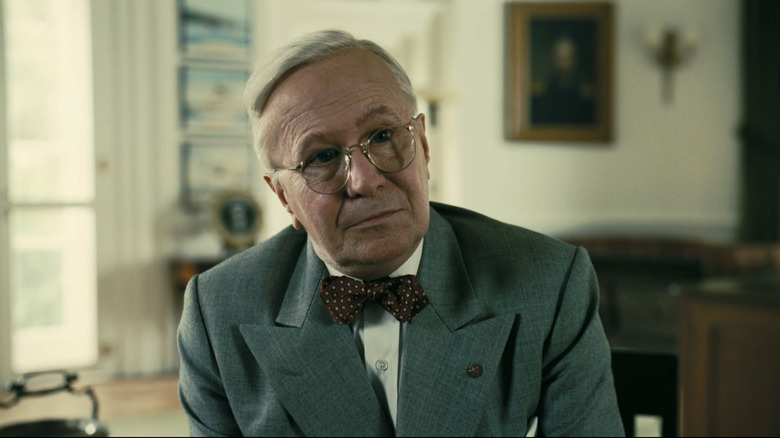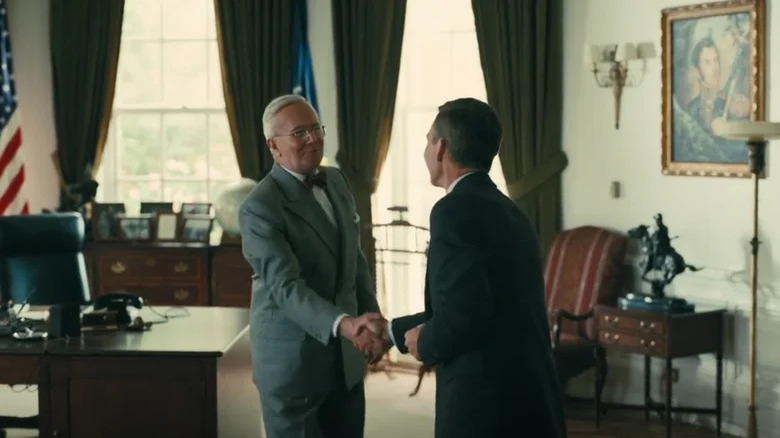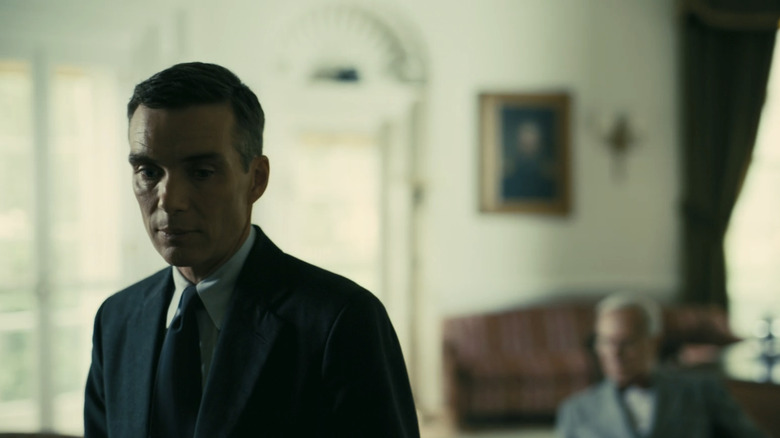In his review of “Oppenheimer” for The New Yorker, Richard Brody wrote that “the film is so intent on making Oppenheimer an icon of conflicted conscience that it pays little attention to his character over all.” A prime example of this comes in the form of the Oval Office scene, where, having delivered the atomic bomb to his military bosses, J. Robert Oppenheimer (Cillian Murphy) is called to a meeting with President Harry Truman.
Truman, played by Gary Oldman in a very brief cameo role, is positively giddy following his decision to drop the bomb on Hiroshima and Nagasaki, yet finds himself faced with a chastened Oppie, who feels as though he has “blood on his hands.” The President balks at this confession, waving a handkerchief in the physicist’s face before declaring that the citizens of the leveled Japanese cities care only about who dropped the bomb, not who made it. The tense scene comes to an end when Oppenheimer leaves the room in a state of shock and overhears Truman tell his aide, “Don’t let that crybaby back in here.”
Director Christopher Nolan explained the “crybaby” scene as a miscommunication between the pair, rather than something designed to indict Truman as a heartless warmonger — as many have interpreted it. Conversely, some see Truman’s pushback against Oppie’s guilt in this moment as simply another version of the physicist’s wife Kitty (Emily Blunt)’s perfectly valid assertion that, “You don’t get to commit the sin and then have us all feel sorry for you that it had consequences.” But while we could endlessly debate the meaning of this scene and the very real issues into which it taps, one thing that certainly isn’t up for debate is that Oldman is just a damn fine actor.
The man shows up for all of three minutes in a 180-minute movie and helps produce one of its most memorable moments. Having worked with the esteemed star multiple times, this is surely something Nolan was counting on when he asked Oldman to play Truman. But he had to agree to the actor’s one condition before it could actually happen.
Gary Oldman’s Oppenheimer appearance came with a caveat
The Oval Office scene represents one of those unbelievable moments in filmmaking where so many things had to coalesce in order for it to happen. Just days before the shoot, the original location of the Nixon Library fell through, prompting a frantic search for a replacement. That replacement was found in the form of a hurriedly reconstructed Oval Office set from HBO’s “Veep,” hauled out of storage and erected on a Universal sound stage. If that debacle sounds almost as intense as Oppie’s actual meeting with Truman, consider that production designer Ruth De Jong was also working with the knowledge that the venerable Gary Oldman had already been confirmed to appear in the scene.
The pressure really was on, as Oldman had also agreed to take time out of his schedule shooting the brilliant and underseen Apple TV+ series “Slow Horses” to film his cameo. In fact, as Oldman told the Wall Street Journal, Christopher Nolan had to agree to Oldman’s condition that he be allowed to wear a prosthetic cap and wig, so as to not alter his appearance before he returned to the show. The actor explained that he is “tethered to” his role as the slovely, jaded MI5 agent Jackson Lamb in “Slow Horses,” to the point that “it dictates if [he does] anything else.” He continued:
“I did a day on ‘Oppenheimer.’ I said to Chris Nolan, ‘I would love to come and do it, but I’m going to have to wear a prosthetic cap and a wig and I can’t cut my hair. So if you can deal with that, then I’d love to come and do it. And if you don’t want wigs, then you have to get someone else to do it.’ Lamb is never far away in that sense.”
Gary Oldman was never going to say ‘no’ to Christopher Nolan
Prior to “Oppenheimer” Gary Oldman worked with Christopher Nolan on the Dark Knight trilogy, in which he famously portrayed Jim Gordon. Clearly, their collaboration was a fruitful one, and not just because it helped produce three (well, maybe two) classic Batman movies. The actor has spoken about his appreciation for Nolan, revealing that he actually received one of the best pieces of direction of his career from the British filmmaker. In an interview for the “Happy Sad Confused” podcast, he recalled that during the filming of a scene for a Batman movie, Nolan gave him the simple note: “There’s more at stake.” Oldman spoke about this being “a fantastic piece of direction,” and clearly appreciated his director’s terse approach to nudging his performance.
So, you can imagine that if anything was going to take him away from a role to which he felt “tethered,” then it was going to be Nolan. Aside from the fact that actors generally aspire to work with one of the few directors who captures widespread attention while maintaining an artful approach to movie-making, Oldman clearly values his relationship with Nolan — and “Oppenheimer” was all the better for it. What’s more, the actor’s striking Harry Truman performance is somehow more impressive when you know he had to get out of the mode of playing Jackson Lamb — who’s back in action for season 4 of the best spy show on streaming — in order to play the former U.S. President.










